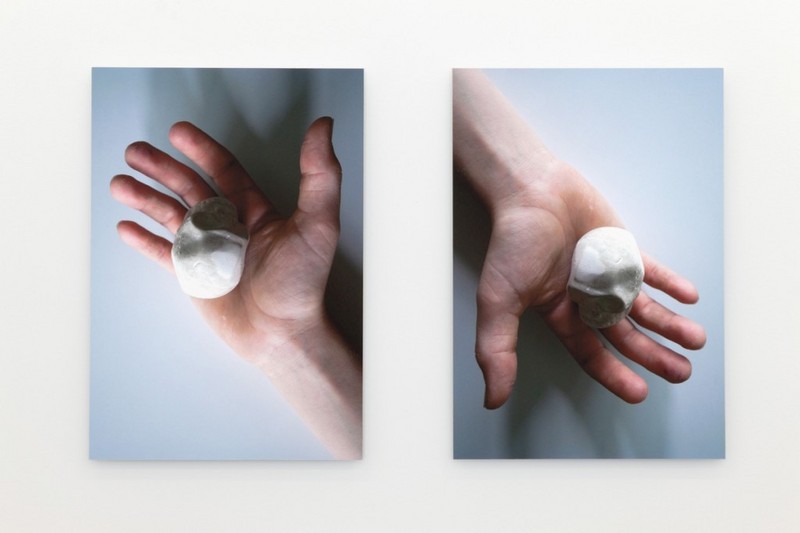Jonathon Monk
11 Sep - 18 Oct 2014

© Jonathan Monk
Mistakes Mistakes Mistakes, 2014
Two c-prints mounted on aludibond
16.9 x 11.8" / 43 x 30cm each
Mistakes Mistakes Mistakes, 2014
Two c-prints mounted on aludibond
16.9 x 11.8" / 43 x 30cm each
JONATHAN MONK
I went to school with someone called Jonathon Monk
11 September - 18 October 2014
Casey Kaplan is pleased to announce I went to school with someone called Jonathon Monk, an exhibition by Jonathan Monk (b. 1969, Leicester, UK). Monk’s work is a continuing engagement with notions of authorship and identity, as he recasts iconic works of art with a consistent and incisive humour.
In this exhibition, Monk’s own biography becomes a material as objects assume not only their former contexts, but also their relationship to Monk’s own life as an artist. Through this, works themselves become open to misremembrance and approximation. Sited in the first galleryisA Copy Of Deflated Sculpture No. 1, a facsimile of Monk’s subtly deflated copy of Jeff Koon’s iconic inflatable bunny, exhibited in his 2009 exhibition with the gallery, The Inflated Deflated. Created from photographic documentation, rather than the original’s specifications, the work not only points towards the shifting relationships of the work to Monk himself, but the role these images play in larger structures of commerce and circulation.
This idea carries throughout as Monk navigates his relationship to a wide-ranging group of figures including Carl Andre, Alighiero Boetti, Dan Graham, Paul McCarthy and Paul McCartney, tracing narratives of transformation, and underscoring the myriad of ways in which artworks are evaluated and how objects are embedded in our cultural history. This results in works that function as composite views, which is exemplified in Three Part Piece (untitled wood destroyed). Taking a lost, early wooden sculpture by Carl Andre as its starting point, Monk displays the work in three variations – a charred replica, a photograph of its original condition, as well as video documentation of the work burning. These varied methods of reproduction highlight the almost nebulous connections that shape our complex understanding of an object both as an artwork and a cultural artifact.
In what functions almost as a leveling effect, the same strategies applied to these stalwarts of contemporary art are applied to Monk’s own biography. He allows his own story to unfold alongside theirs, while also acknowledging their formative role in his own personal history and development as an artist. Alluding to an interest in Americana, storytelling, and his own impulse to collect, these works often function in sharp and pointed contrast to each other – the high-finish of steel and Plexiglas is placed alongside works with a homespun, kitsch feel. Monk’s life is charted on the walls in amassed coins from the year he was born until he left America and found souvenir scarves are sewn to form a map of the United States. A pedestal holds a pristinely carved, white marble skull, dulled on its planes from its former life as his son’s eraser. Together, these demonstrate time’s passage, and our ability to rebuild and shape history through the accumulated references and artifacts that survive it.
I went to school with someone called Jonathon Monk
11 September - 18 October 2014
Casey Kaplan is pleased to announce I went to school with someone called Jonathon Monk, an exhibition by Jonathan Monk (b. 1969, Leicester, UK). Monk’s work is a continuing engagement with notions of authorship and identity, as he recasts iconic works of art with a consistent and incisive humour.
In this exhibition, Monk’s own biography becomes a material as objects assume not only their former contexts, but also their relationship to Monk’s own life as an artist. Through this, works themselves become open to misremembrance and approximation. Sited in the first galleryisA Copy Of Deflated Sculpture No. 1, a facsimile of Monk’s subtly deflated copy of Jeff Koon’s iconic inflatable bunny, exhibited in his 2009 exhibition with the gallery, The Inflated Deflated. Created from photographic documentation, rather than the original’s specifications, the work not only points towards the shifting relationships of the work to Monk himself, but the role these images play in larger structures of commerce and circulation.
This idea carries throughout as Monk navigates his relationship to a wide-ranging group of figures including Carl Andre, Alighiero Boetti, Dan Graham, Paul McCarthy and Paul McCartney, tracing narratives of transformation, and underscoring the myriad of ways in which artworks are evaluated and how objects are embedded in our cultural history. This results in works that function as composite views, which is exemplified in Three Part Piece (untitled wood destroyed). Taking a lost, early wooden sculpture by Carl Andre as its starting point, Monk displays the work in three variations – a charred replica, a photograph of its original condition, as well as video documentation of the work burning. These varied methods of reproduction highlight the almost nebulous connections that shape our complex understanding of an object both as an artwork and a cultural artifact.
In what functions almost as a leveling effect, the same strategies applied to these stalwarts of contemporary art are applied to Monk’s own biography. He allows his own story to unfold alongside theirs, while also acknowledging their formative role in his own personal history and development as an artist. Alluding to an interest in Americana, storytelling, and his own impulse to collect, these works often function in sharp and pointed contrast to each other – the high-finish of steel and Plexiglas is placed alongside works with a homespun, kitsch feel. Monk’s life is charted on the walls in amassed coins from the year he was born until he left America and found souvenir scarves are sewn to form a map of the United States. A pedestal holds a pristinely carved, white marble skull, dulled on its planes from its former life as his son’s eraser. Together, these demonstrate time’s passage, and our ability to rebuild and shape history through the accumulated references and artifacts that survive it.
